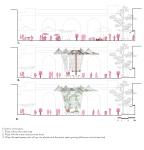Ahmedabad, like many rapidly urbanizing cities worldwide, is experiencing a sharp decline in its green spaces. This lack of greenery not only affects environmental health but also reduces comfort and livability for city dwellers. However, this issue extends beyond Ahmedabad, affecting cities globally. The Urban Tree project is designed to be a replicable model, demonstrating how sustainable urban interventions can create a meaningful impact in cities worldwide.
The Urban Tree project is an innovative, sustainable structure that integrates nature with urban infrastructure, following the idea of 'Architecture of Impermanence.' It is the concept of embracing transience and adaptability in design, moving away from the traditional notion of permanence, and focusing on temporary structures, re-use, and adaptability to create spaces that are responsive to change and the needs of the community. This intervention provides much-needed shade and comfort and educates people on the importance of recycling and sustainability.
Bhadra Plaza, a historically and culturally significant space in Ahmedabad, was chosen as the pilot site for the Urban Tree project. Formerly a royal ceremonial ground, today's plaza functions as a pedestrian space but faces challenges such as congestion and a lack of shaded rest areas. The introduction of the Urban Tree in this space serves as a demonstration of how sustainable solutions can enhance crowded public spaces, benefiting both vendors and visitors alike.
This site serves as an initial example of Urban Tree implementation. Once the public adapts to the concept and benefits from its presence, similar structures can be introduced in other urban spaces, both within Ahmedabad and globally, to create a greener, more sustainable urban environment.
2024
Main Structure: Constructed from paper tubes after doing all the necessary coating for waterproofing and fire protection, ensuring both sustainability and structural integrity.
Skin Material: Jute rope, serving as a base for seed paper application and promoting plant growth.
Seed paper pulp, sprayed over the jute rope, embedded with climbers and other suitable plant species that will germinate and grow over time, forming a natural canopy. This evolving shade element protects from the harsh sun while adding greenery to the cityscape.
Functional Features: Openable seating and desks catering to urban dwellers, especially street vendors who lack adequate infrastructure.
Energy Source: Integrated solar panel, providing renewable energy for lighting or charging small electronic devices.
Timespan of the Project:
The Urban Tree project follows a one-year lifecycle, designed to integrate seamlessly with Ahmedabad’s seasonal changes:
Summer (Installation Phase): The structure is set up to provide immediate shade and serve as a functional urban intervention.
Monsoon (Growth Phase): The seed paper dissolves into the soil, allowing plants to take root and begin growing.
Winter (Maturity Phase): Fully grown plants form a natural canopy, offering enhanced shading and environmental benefits.
End of Lifecycle: After a year, the structure will naturally decompose, contributing to the soil while paving the way for new installations.
Dhwani Prajapati (Designer)
Nuru Karim (Instructor)
Niyati Naik (Instructor)
Jatin Nimmala (Teaching Associate)











